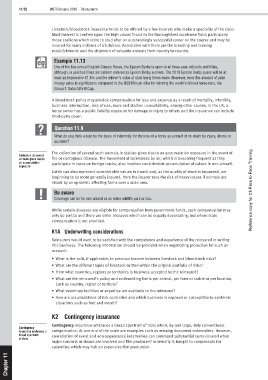Page 322 - M97TB9_2018-19_[low-res]_F2F_Neat2
P. 322
11/32 M97/February 2018 Reinsurance
Livestock/bloodstock insurance tends to be offered by a few insurers who make a speciality of the class.
Most interest is centred upon the high values found in the thoroughbred racehorse field; particularly
those stallions which retire to stud after an outstandingly successful career on the course and may be
insured for many millions of US dollars. Associated with them are the breeding and training
establishments and the shipment of valuable animals from country to country.
Example 11.13
One of the five annual English Classic Races, the Epsom Derby is open to all three-year-old colts and fillies,
although, in practice fillies are seldom entered as Epsom Derby runners. The 2018 Epsom Derby purse will be at
least an impressive £1.5m and the winner’s value at stud many times more. However, even this amount of prize
money pales in significance compared to the US$10m on offer for winning the world’s richest horse race, the
Group 1 Dubai World Cup.
A bloodstock policy may provide compensation for loss and expense as a result of mortality, infertility,
business interruption, loss of use, mare and stallion unavailability, among other causes. In the UK, a
horse owner has a public liability exposure for damage or injury to others and the insurance can include
third-party cover.
Question 11.9
What do you think would be the basis of indemnity for the loss of a horse as a result of its death by injury, illness or
accident?
The collection of several such animals in stables gives rise to an accumulation exposure in the event of
Collection of several
animals gives rise to fire or contagious disease. The movement of racehorses by air, which is becoming frequent as they
an accumulation participate in races on foreign tracks, also involves considerable accumulation of values in one aircraft.
exposure
Cattle can also represent considerable values in transit and, as the quality of stock is improved, are
beginning to be more generally insured. Here the insurer runs the risk of heavy losses if animals are
struck by an epidemic affecting farms over a wide area.
Be aware Reference copy for CII Face to Face Training
Coverage can be for one animal or an entire wildlife park or zoo.
While certain diseases are eligible for compensation from government funds, such compensation may
only be partial and there are other diseases which can be equally devastating, but where state
compensation is not provided.
K1A Underwriting considerations
Reinsurers would want to be satisfied with the competence and experience of the reinsured in writing
this business. The following information should be provided when negotiating protection for such an
account:
• What is the split, if applicable, in premium income between livestock and bloodstock risks?
• What are the different types of livestock written within the original portfolio of risks?
• From what countries, regions or territories is business accepted by the reinsured?
• What are the reinsured’s policy and underwriting limits per animal, per farm or stable or per location,
such as country, region or territory?
• What veterinary facilities or expertise are available to the reinsured?
• How are accumulations of risk controlled and which business is exposed or susceptible to epidemic
situations such as foot and mouth?
K2 Contingency insurance
Contingency insurance embraces a broad spectrum of risks which, by and large, defy conventional
Contingency
insurance embraces a categorisation. At one end of the scale are examples such as missing document indemnities. However,
broad spectrum cancellation of event and non-appearance indemnities can command substantial sums insured when
of risks
major concerts or shows are involved and film producers’ indemnity is bought to compensate for
calamities which may halt an expensive film production.
11
Chapter

